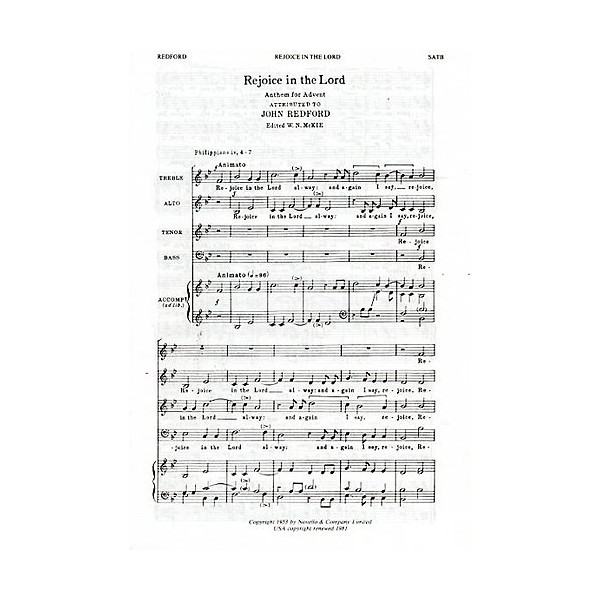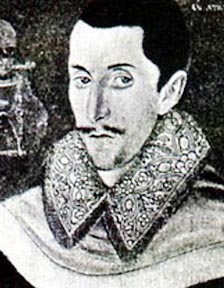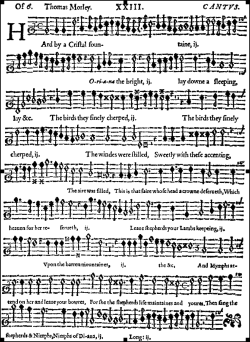<Back to Index>
- Composer and Organist John Redford, c. 1500
- Composer and Organist Thomas Morley, 1557
PAGE SPONSOR

John Redford (c. 1500 - died October or November 1547) was a major English composer and organist of the Tudor period.
From about 1525 he was organist at St Paul's Cathedral (succeeding Thomas Hickman) and choirmaster there from 1534. Many of his works are represented in the Mulliner Book. All his organ music is liturgical and mostly vocal in style, but some are in a distinctively keyboard style containing idiomatic ornamentation, and require high technical skill.
Unlike most of his colleagues, Redford also wrote songs and produced masques, or dramatic entertainment for the court. As he also held the post of Almoner and Master of the Choristers, Redford was in overall charge of the choristers' education, and this included performing entertainments at court. The most celebrated of these entertainments is the morality play, The Play of Wyt and Science (written ca 1530 - 1550), some of which is now lost.
He also wrote a number of poems, including the 23 verse Nolo mortem peccatoris, which was set to music by Thomas Morley, who was a later organist at St Paul's.
Another poem is The Chorister's Lament, in which choirboys complain of the cruel beatings meted out to them:
We have a cursyd master, I tell you all for trew
so cruell as he is was never Turke or Jue.
he is the most unhappiest man that ever ye knewe,
for to poor syllye boyes he wurkyth much woe.
Do we never so well, he can never be content,
but for our good wylles we ever more be shente
[punished],
ofttimes our lytle butokes he dooth all to rent,
that we, poore sylye boyes, abyde much woe.
We have many lasshes to lerne this peelde
[wretched] song,
that I wyll not lye to you now & then among;
out of our butokes we may plucke the stumpes thus long
that we, poore sylye boyes, abyde much woe.


Thomas Morley (1557 - October 1602) was an English composer, theorist, editor and organist of the Renaissance, and the foremost member of the English Madrigal School. He was the most famous composer of secular music in Elizabethan England and an organist at St Paul's Cathedral. He and Robert Johnson are the composers of the only surviving contemporary settings of verse by Shakespeare.
Morley was born in Norwich, in East England, the son of a brewer. Most likely he was a singer in the local cathedral from his boyhood, and he became master of choristers there in 1583. However, Morley obviously spent some time away from East England, for he later referred to the great Elizabethan composer of sacred music, William Byrd, as his teacher; while the dates he studied with Byrd are not known, they were most likely in the early 1570s. In 1588 he received his bachelor's degree from Oxford, and shortly thereafter was employed as organist at St. Paul's in London. His young son died the following year in 1589.
In 1588 Nicholas Yonge published his Musica transalpina, the collection of Italian madrigals fitted with English texts, which touched off the explosive and colorful vogue for madrigal composition in England. Morley obviously found his compositional direction at this time, and shortly afterwards began publishing his own collections of madrigals (11 in all).
Morley lived for a time in the same parish as Shakespeare, and a connection between the two has been long speculated, but never proven. His famous setting of "It was a lover and his lass" from As You Like It has never been established as having been used in a performance of Shakespeare's play, though the possibility that it was is obvious. Morley was highly placed by the mid 1590s and would have had easy access to the theatrical community; certainly there was then, as there is now, a close connection between prominent actors and musicians.
While Morley attempted to imitate the spirit of Byrd in some of his early sacred works, it was in the form of the madrigal that he made his principal contribution to music history. His work in the genre has remained in the repertory to the present day, and shows a wider variety of emotional color, form and technique than anything by other composers of the period. Usually his madrigals are light, quick-moving and easily singable, like his well-known "Now is the Month of Maying" (which is actually a ballet); he took the aspects of Italian style that suited his personality and anglicized them. Other composers of the English Madrigal School, for instance Thomas Weelkes and John Wilbye, were to write madrigals in a more serious or sombre vein.
In addition to his madrigals, Morley wrote instrumental music, including keyboard music (some of which has been preserved in the Fitzwilliam Virginal Book), and music for the broken consort, a uniquely English ensemble of two viols, flute, lute, cittern and bandora, notably as published by William Barley in 1599 in The First Booke of Consort Lessons, made by diuers exquisite Authors, for six Instruments to play together, the Treble Lute, the Bandora, the Cittern, the Base-Violl, the Flute & Treble-Violl.
Morley's Plaine and Easie Introduction to Practicall Musicke (published 1597) remained popular for almost two hundred years after its author's death, and remains an important reference for information about sixteenth century composition and performance.